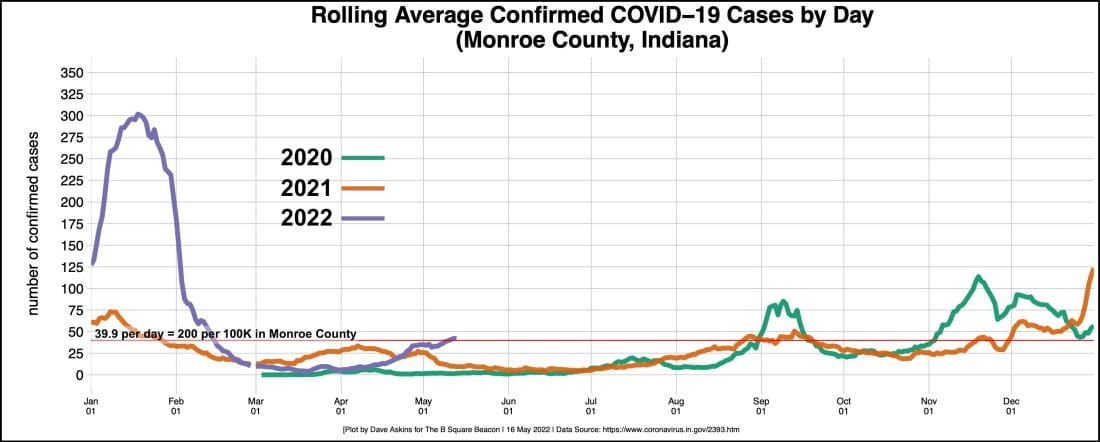Pandemic news: Monroe County could see “medium” level of community spread on next map update


The number of daily COVID-19 cases recorded in Monroe County has grown steadily in the second week of May after leveling off in late April.
Through May 13, the rolling 7-day average of daily cases in Monroe County stands at about 42.
That is greater than 39.9—which is Monroe County’s daily average equivalent of the 200 cases-per-week per-100,000 population metric used by the Centers for Disease Control (CDC) as a threshold for its community spread levels.
The current CDC map still pegs the community spread of the virus In Monroe County at a “low” level—which is the lowest of its three categories (low, medium, and high).
But by Thursday (May 19), when the CDC map will be updated based on numbers through Wednesday, Monroe County’s category could change to “medium.”
That will depend on how numbers look over the next two days. If there’s a clear drop, possibly due to the exodus of Indiana University students on summer break, then Monroe County might nudge back down to just under the 200 cases-per-week per-100,000 population metric.
A drop in COVID-19 gene copies in Bloomington’s sewage at the Blucher Poole wastewater treatment facility, which serves student districts on the northern half of town, could signal an upcoming drop in COVID-19 case numbers. From May 2 to May 9, the measurement at Blucher Poole dropped from 9,200 to 240 gene copies per 100 ml.
Monroe County health administrator Penny Caudill responded to an emailed B Square Bulletin question by writing, “I do expect that we will move to CDC medium community level…this week.”
Associated with each level are different CDC recommendations.
For Monroe County’s current low level (green), the CDC recommends: staying up to date with COVID-19 vaccines; and getting tested if you have symptoms. For the next level (medium, yellow), the CDC adds talking to your healthcare provider about whether you need to wear a mask and take other precautions—if you are at high risk for severe illness.
Only for the highest level (red) does the CDC recommend wearing a mask indoors in public.
Given the current low hospitalization numbers, it’s not likely the CDC level for Monroe County will soon increase to “high.” Caudill wrote, “Unless hospital demand surges, we won’t move into the high community level, since the new system is focused on how stressed the hospitals are.”

The hospitalization numbers for Monroe County’s region remain low, but they continue to increase. Indiana’s Health District 8, which is made up of 7 counties including Monroe, had a census of 18 COVID-19 patients on Monday this week.
That’s twice as many as at the end of the first week of May. But that compares to more than 170 at the peak of the pandemic.
One source of confusion about some of the numbers are the default display settings for counties on the Indiana health department’s dashboard map.
While the CDC guidelines are expressed in per-100,000 population, the default display for Indiana’s dashboard is per-10,000 population. That’s a pretty straightforward difference to spot—a factor of ten.
But not as easy to spot is a difference in time frame. The CDC uses a one-week timeframe for its stats. The default display for the Indiana dashboard is one month. The time period can be selected with a dropdown menu.
Here’s how the CDC classification scheme works:





Comments ()